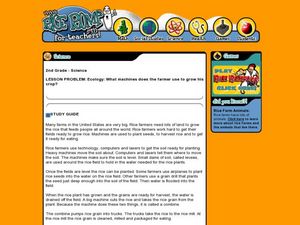Curated OER
Human Epidermal Cells
Learners explore epidermal cells. After following specified procedures for removing epidermal cells from their wrist, students view the cells with the use of a microscope. After creating a drawing of their observation, learners label the...
Curated OER
Food and Kitchen Safety Lab
Students review kitchen management, safety, and sanitation rules, and practice applying safety and sanitation rules in kitchen lab by preparing chicken stir-fry over rice while maintaining safe working environment. Students then complete...
Curated OER
Different Types of Changes (1.2)
In this recognizing different types of changes worksheet, students answer questions about such things as reversible change, irreversible process, climatic change, filtration process, physical change, and change in the state of a...
Curated OER
Acids and Bases
In this acids and bases worksheet, high schoolers learn the differences between an acid and a base and how pH is used to measure the strength of an acid or base. Students read about pH and acid rain. This worksheet has 10 matching and 20...
Curated OER
Acids and Bases
In this acid and base worksheet, students read about the characteristics of acid and bases, the pH scale and neutralization reactions. Students match 10 terms with their definitions related to acids, bases and pH, they identify acids and...
Curated OER
Currents Challenge
In this science worksheet, students read the article related to currents and complete the exercises that are multiple choice and short answer.
Curated OER
Acids, Bases, and Buffers
In this acids and bases worksheet, students test the pH of different solutions to determine if it is basic or acidic. Students complete 7 short answer questions based on their results.
Curated OER
Combating Viruses at Lisbon Central School
Students discuss the spread of viruses. For this service learning lesson, students educate others about the importance of hand washing to stop the spread of germs. They plan a service learning project to prevent virus related diseases.
Curated OER
Making Hail
Fourth graders investigate the different types of precipitation and conduct a hail experiment. They identify the types of precipitation during a slideshow, and define key vocabulary terms. Next, in small groups they follow the...
Curated OER
Lab 23-Follow Up Questions-Conductivity
In this conductivity learning exercise, students answer post lab questions about substances that transferred electrons resulting in electricity flowing through the conductivity leads use to test each substance.
Curated OER
The Sponges
In this sponge worksheet, students read about the different parts of a sponge and answer 20 short answer questions that follow. They color and label different sponge drawing.
Curated OER
The Salmon Stream and Vegetation
Students explore the ecosystem and food chain by researching Pacific Salmon. In this fish habitat lesson, students discover the life cycle for salmon, where they spawn and what they eat to survive the harsh elements. Students participate...
Curated OER
Paper Chromatography K-12 Experiment
Students study chromatography and how they can distinguish between the different pigments in a color. In this chromatography lesson students separate a mixture of dyes in soluble ink then record the colors they see.
Curated OER
Shake It Up
Learners explore the three types of mixtures through the use of interactive video. They experiment making mixtures using a variety of ingredients, while observing, comparing and contrasting, and identifying the types of mixtures.
Curated OER
Photosynthesis Explored
Students observe the production of gas as an effect of photosynthesis. In this biology lesson plan, students perform an experiment with pondweed and make measurements and predictions about photosynthesis and the plant.
Curated OER
Properties of Soaps
Students investigate 3 types of soap. In this properties of soaps lesson plan, students test soap with pepper and observe the reaction between the two. They make observations of the 3 types of soaps and make a chart to compare each. They...
Curated OER
Relationships and Biodiversity Lab
In this relationships and biodiversity worksheet, students investigate the relationships between 4 plants sample using 7 different tests. These include looking at structural characteristics of the plants, seeds and stems, using paper...
Curated OER
Esters as Food Flavorings
Students produce esters in the laboratory by combining different carboxylic acids with different alcohol. In this esterification lesson plan, students experiment with 3 carboxylic acids and 3 alcohols to produce 3 esters with fruit like...
Curated OER
The Lake Trip
In this pollution and animals worksheet, students read and discuss a short story on one families trip to a lake and their encounters with pollution and Eastern Blackbirds. Students then answer 6 short answer questions referring back to...
Curated OER
The Lost Hydroponics Chamber Lesson
Students understand the definition of hydroponics. In this space hydroponics less, students simulate the experiment conducted in space. Students answer questions based on their experiment.
Curated OER
Machines Rice Farmers Use
Second graders investigate rice farming. In this farming equipment lesson, 2nd graders discover what type of equipment is needed to get rice farms ready to plant. Students gain knowledge about what a combine does and how it is important...
Curated OER
The Shape of Things
Sixth graders read and discuss information regarding the shape and attributes of an eggshell. In this shape of things lesson, 6th graders gather relevant information that pertains to the incubation and formation of an eggshell. Students...
Curated OER
Reptiles and Amphibians
Fourth graders explore biology by viewing animal videos in class. In this amphibian and reptile lesson plan, 4th graders identify the key differences between reptiles, amphibians and other animal classifications. Students view video...
Curated OER
Working It Out
Students participate in a simulation in which they are arbitrarily assigned different work roles and compare their experiences to those discussed in a New York Times article about the racial divisions in a pork production plant.

























